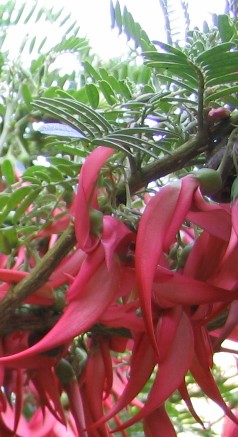 Also called lobster’s claw, this native of New Zealand’s North Island, is a small bushy evergreen shrub in the legume family (Fabaceae) . The dark green to gray green leaves are six inches long and divided into fifteen to twenty pairs of leaflets. In spring and early summer, the plant produces clusters of fifteen to twenty five bright pink to red flowers that are waxy, three inches long, and look like a parrot’s beak or lobster claw, accounting for the common names. In New Zealand the plant is called kakabeak, referring to the kaka, a native parrot there. The fruit is a pea-like pod with numerous small seeds. Parrot’s beak is an excellent choice for growing on a wall or trellis because of its sprawling habit. It is a short-lived plant but can be easily propagated. It is endangered in New Zealand. The generic name, Clianthus comes from Greek, kleios meaning glory and anthos meaning flower. The specific name, puniceus means blood red and refers to the color of the flower.
Also called lobster’s claw, this native of New Zealand’s North Island, is a small bushy evergreen shrub in the legume family (Fabaceae) . The dark green to gray green leaves are six inches long and divided into fifteen to twenty pairs of leaflets. In spring and early summer, the plant produces clusters of fifteen to twenty five bright pink to red flowers that are waxy, three inches long, and look like a parrot’s beak or lobster claw, accounting for the common names. In New Zealand the plant is called kakabeak, referring to the kaka, a native parrot there. The fruit is a pea-like pod with numerous small seeds. Parrot’s beak is an excellent choice for growing on a wall or trellis because of its sprawling habit. It is a short-lived plant but can be easily propagated. It is endangered in New Zealand. The generic name, Clianthus comes from Greek, kleios meaning glory and anthos meaning flower. The specific name, puniceus means blood red and refers to the color of the flower.
Type: Evergreen shrub
Outstanding Feature: Flowers
Form: Sprawling
Growth Rate: Moderate
Bloom: Clusters of three inch long, pink to red, pendulous, waxy flowers in spring and early summer
Size: 13’ H x 10’ W
Light: Full sun
Soil: Fertile, medium moist, well-drained
Hardiness: Zones 8-9
Care: Plant in a site that is protected from cold wind; mulch in winter to protect the base of the plant; prune by one third immediately after flowering.
Pests and Diseases: Slugs, snails, caterpillars, mites
Propagation: Seed; semi-ripe cuttings; stem layering
Outstanding Selections:
‘Red Cardinal’ (Red flowers)
‘Albus’ (White flowers)
‘Roseus’ (Deep red flowers).
